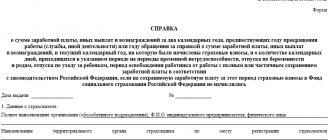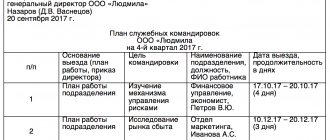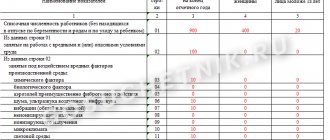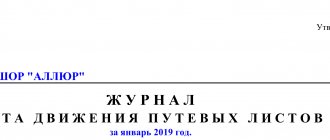The use of form M-11 or a demand invoice occurs when inventory is transferred within an enterprise from one department to another, most often when production waste, defective products or leftover unspent materials are delivered to a warehouse. This document is also used when goods and materials are transferred from one materially responsible person to another, thus determining who, at one time or another in the company’s activities, is responsible for their safety.
The preparation of the invoice request is carried out by a person whose powers include control over the movement of inventory items in the organization.
- Form and sample
- Free download
- Online viewing
- Expert tested
FILES
When is M-11 compiled?
Let's consider the movement of goods within the organization.
Inventory and materials arrive at the warehouse, and the storekeeper draws up a document reflecting the receipt: for example, receipt order M-4 (form according to OKUD 0315003). The data is also reflected in the materials accounting card, for example, in form M-17 (OKUD 0315008) (forms M-4 and M-17 can be downloaded below).
The goods are then stored in the warehouse until shipment. The warehouseman can ship goods to both contractors (suppliers, customers) and internal users (employees, owners, founders).
If there is a need to ship goods within the company, then in this case an M-11 invoice is issued. The basis for issuing a demand invoice is the request for material assets located in the warehouse.
The invoice should be printed in three copies:
- one is kept by the sender;
- the second is transferred to the accounting department;
- the third copy is in stock.
Write-off of customer-supplied materials using the “Demand-invoice”
The program provides the ability to keep records of operations for processing customer-supplied materials, i.e. materials transferred for processing by third-party customers. The document “Requirement-invoice” has a tab “Customer Materials”, which reflects the transfer of customer materials to production. They are accounted for in the off-balance sheet account 003.01 “Materials in warehouse”, and for processing they are transferred to account 003.02 “Materials transferred to production”.
Fig. 19 Document “Request-invoice” - tab “Customer Materials”
Thus, the “Demand-invoice” document can be considered a universal document for the write-off and transfer of materials.
Details and filling procedure
Let's consider the procedure for filling out M-11. The invoice is drawn up by the employee of the department where the inventory items are stored and indicates:
- date of compilation;
- structural units of the sender and recipient;
- data on inventory items (name, item number, unit of measurement, quantity);
- if a transaction coding system is used, the corresponding code.
Data on inventory items can also be filled in by the person responsible for production.
The document is internal, therefore it is signed only by the employees responsible for the operation - materially responsible persons (hereinafter - MOL). The warehouse employee checks that the signature of the recipient or transmitter, as well as the person through whom the transfer is made, is present. MOLs must indicate their full name and position.
After this, the accountant fills out the “corresponding account” column and indicates the cost indicators of inventory items.
Request invoice, form 0504204, sample filling
What is the document for and where is it used?
A demand invoice is filled out and issued for one single purpose: to document the transfer of value from one employee and financially responsible person to another. This helps to control the safety and quantity of entrusted goods or materials.
Cases when drawing up an invoice is required:
- transfer of finished products to the enterprise warehouse;
- write-off of expired or spoiled products;
- returning balances to the warehouse or issuing inventory;
- posting of goods after the liquidation of divisions.
The use of a unified form is optional . Back in 2012, the Ministry of Finance allowed enterprises to use forms developed and approved independently (Information of the Ministry of Finance of the Russian Federation N PZ-10/2012). However, the requirement-invoice of a unified form is still actively used in document flow, as it is the most convenient.
The demand invoice is mainly used in trading companies and in production, where there are many warehouses with different goods or products, and valuables are often moved and recorded.
Invoice storage periods
After processing information from M-11, the accountant must ensure its archiving and storage. You can store the archive not only in the organization, but also in a public or private archive. Since the demand invoice is a primary accounting document, the storage period cannot be less than the period specified in Art. 29 of Law No. 402-FZ - at least 5 years after the reporting year.
IMPORTANT!
Clause 4 art. 283 of the Tax Code of the Russian Federation provides for a longer storage period for documents confirming losses of previous periods.
Creating a “Request-invoice” document based on another document
1C programs have many different useful functions, one of which is to enter a document based on.
The document that we are considering as an example can be entered according to the “Receipt” document, which was issued earlier. To do this, you need to open the receipt document and click on “Create based on”. Then, from the list that appears, you must select “Request-invoice” and, if necessary, correct this document.
Responsibility for drawing up and recording the invoice
Despite the fact that this document is internal, it accompanies the movement of values, and the persons who signed it are financially responsible. If something unexpected happens to the property: theft, damage, other loss, then MOL’s liability may even be criminal. Also, on the basis of M-11, warehouse and accounting are carried out. The storekeeper and accountant are responsible for the correct reflection of accounting data. Accounting data is used to carry out inventories and is also part of accounting and tax reporting.
Responsibility for the absence of a document is provided for in Art. 120 Tax Code of the Russian Federation.
Form of limit-fence cards M-8
M 11, demand invoice
Receipt order form M-4
In what case is the M-11 form used?
A demand invoice is a primary accounting document used to document the movement of materials between responsible persons and between departments of the company. This form differs from a limit-fence card in that it is used to document the movement of several items of materials. It is applied if the inventory items reflected in it do not have consumption (withdrawal) limits established.
A demand invoice must be issued for each fact of movement of materials.
This document is also filled out when recording the return of inventory items unused during production, when accepting defective products and waste into the warehouse, etc.
To move valuables
When moving valuables within one enterprise, a demand invoice is also issued . For this, use the unified form TORG-13 or form 0504204.
The invoice requirement can be generated in the appropriate program at the time of release from the warehouse or acceptance into it. A document is drawn up only when materials, products, goods, and not fixed assets of the company are moved.
When filling out the form please indicate:
- details of the enterprise;
- number and date of compilation;
- information about the sender and recipient of the goods and the type of activity of this unit (for example, production or storage);
- accounts on which the movement of goods is carried out.
The invoice also indicates the name of the product, its code, quantity and price . An invoice is drawn up directly during the acceptance and delivery of goods.
After signing, the document is given to the accounting department for accounting. In the accounting process, postings 41.01 - 60.01, 41.11 - 41.01 are used.
Filling example:
- First, indicate the name and number of the document: Invoice for internal movement, transfer of goods No. 1, date January 1, 2018.
- Then it is mandatory to indicate the name and all codes of the enterprise to identify it (according to OKPO, type of activity according to OKDP).
- Next, you need to enter the name of the sender (for example, warehouse No. 1) and the recipient (workshop No. 17) and the corresponding account.
- The following table lists all the goods that are transferred and their value. For example, boxes, 100 pieces, price 20 thousand rubles.
- At the very end, the data of the one who released the goods (storekeeper Vasyutin I.N.) and the one who accepted it (head of the workshop T.V. Sverdlov) is entered.
A note is also made stating that the goods, in terms of quantity and proper quality, completely coincide with those stated in the invoice.
To write off unusable goods
The standard form of claim-invoice for write-off (M-11) is required for write-off only if the company has no limits on receiving materials. If the enterprise has consumption limits, then the release of valuables is done on the basis not of M-11, but of limit cards (M-8). The receipt of goods is registered with a receipt order.
Unusable goods are also written off according to an act or order for write-off, and this happens in two cases:
- When transferred for further use.
- During liquidation (for example, disposal).
A write-off act or order is prepared as the values are used . Goods are written off at average cost or original price.
The goods may also be written off in the production report for the shift. This is possible in the production of any product, as well as in the provision of services to divisions of the enterprise. In this case, the report will need to include the name, quantity of goods, prices, and materials from which it is made. The report is filled out in the 1C program.
Important! Write-off of goods is carried out if they have expired or are morally obsolete. In the event of a fire or flood, as well as other causes of damage, a procedure for disposal of valuables may also be carried out.
What form is used when writing off?
Form M-11 was approved by Resolution of the State Statistics Committee of October 30, 1997 No. 71a. The completed copy is a strict reporting form and must be kept for 5 years. The document is always created in writing. It has nine required columns.
The invoice must indicate:
- name of the structural unit;
- transaction type code;
- accounting unit of production;
- a complete list of product names with product numbers;
- serial number according to the warehouse accounting book;
- the cost of the transferred valuables and the amount excluding VAT.
The invoice is drawn up in two copies and confirms the fact that the material has been written off and posted in a new location. After signing, M-11 is transferred to the accounting department, which is responsible for recording the movement of materials. A document is issued for each write-off of goods.
Filling example:
- In the “header” we indicate the document number and the name of the company. For example, Requirement-invoice No. 1. Organization: JSC "Krymstroy".
- The code according to OKPO and the form according to OKUD are entered next to it.
- Next, we indicate the date of compilation and the transaction code, as well as the name of the sender of the valuables: January 1, 2021, code - 9305, structural unit - warehouse No. 1 of Krymstroy OJSC.
- The next column after “Sender” is called “Recipient”. The name of the department is also indicated here (for example, warehouse No. 2 of Krymstroy OJSC, type of activity: storage).
- The debit of the synthetic account is recorded in the “Corresponding account” column. Under the first part of the invoice is the signature and personal data of those through whom the movement is carried out and who requested the materials.
- The most important part of the table: a listing of all materials, their quantities and prices (for example, construction boards - 10 thousand pieces, price: 200 thousand rubles).
The quantity in the columns indicates the one that was requested and the one that was actually released. You can also indicate the serial number according to the warehouse card file. - In the “Corresponding account” column, enter a synthetic (and, if available, analytical) accounting account, name and item number of materials.
The price (excluding VAT) per unit of goods and the total amount (excluding VAT) are also indicated. - M-11 also has a reverse side, on which the table continues.
At the end, the signature of the person who received the valuables and the one who wrote them off is affixed. For example, the warehouse manager I.N. Fedorov was released, the warehouseman A.S. Sidorov was given the release.
In 1C Accounting you need to create a demand invoice and fill in all the fields. Next, you can use postings 20.01 - 10.01 to write off materials or 003.02 - 003.1 to write off customer-supplied materials for production. When writing off spoiled goods, 91.2 - 94 are used.
Recommendations for filling out the invoice request
The form is used to document the movement of inventories for both structural and separate units located separately. When filling out the document, take into account:
- Data on transaction type codes is indicated only when maintaining automated accounting, in which each transaction is assigned an individual number.
- The document is intended to confirm the transfer of one or more product items. Each type of inventory is indicated on a separate line.
- To account for inventories, units from the OKEI classifier are used.
- The cost indicators for the supply of item items are indicated without VAT at inventory prices.
A demand invoice is issued at the time of the operation for each individual case of movement of an inventory item or several item items.
Basic rules for drafting
There are quite serious requirements for filling out ; you must strictly adhere to the form and avoid mistakes.
The employee involved in the preparation of the document bears financial responsibility for the fact that the information entered in the document is reliable, as well as for the consequences that arose as a result of the indication of unreliable, inaccurate or incomplete information specified in the invoice.
The number of goods and materials issued and received according to the invoice must match the actual quantity ; these values must always be checked, since the inspection authorities pay attention to obvious discrepancies.
In unreliable information, the tax service may see criminal intent and an attempt to evade taxes. In this case, the company may be subject to a fine, tax sanctions, or administrative and criminal liability.
Formally, the demand invoice will lose force if the information is incomplete, so all fields must be filled out. And it is imperative that they are filled out correctly. Marks, corrections, strikethroughs, unreadable text, etc. are not allowed on the invoice. If erroneous or inaccurate data is entered, a new copy is filled in.
Who draws up and signs the document
The invoice document is drawn up in two copies . One of them is provided for a warehouse, from the area of which inventory items need to be written off. The second copy must be delivered to the warehouse, which is preparing to accept goods and materials for their further use.
An invoice is drawn up by the person responsible in the company’s structural unit for material assets. He prepares both copies.
The documents are signed twice: by the person who received the goods and materials, and by the person who released them. At the same time, it is important that the signatures are strictly in the field intended for this, otherwise such paper will be considered invalid, since it was not made according to the standard.
After the documents have been drawn up and signed, and commodity transactions have been completed, the invoices are submitted to the company's accounting department for further accounting.
Detailed information on how to fill out the TORG-12 consignment note is provided here. If you are interested in what a consignment note is needed for, read this material.
How to properly prepare a document
The current legislation leaves commercial structures the right to choose: use the standard version of the invoice requirement proposed by Goskomstat, or develop their own sample that meets the legal requirements for the “primary” one. The decision made is fixed in the accounting policy of the enterprise.
If a company prefers to use a standard sample for filling out form M-11 (request-invoice), it finds it on the websites of legal information systems and prepares it in one of the following ways:
- manually;
- in the 1C program;
- in text editors, Excel, etc.
The document consists of two parts: a “header” and a table, which contains complete information about the products released from the warehouse. The information is distributed over two pages, printed on both sides of one A4 sheet.
To obtain forms M-11 (request-invoice), just go to information system websites and find the option offered by Goskomstat. The header of the document states:
- No. according to the internal numbering system for invoice requirements, date of completion.
- Name of the organization.
- Names of the company's divisions, from where and where the values are sent. For example, “Warehouse” and “Production workshop”.
- Accounts for which the operation will be reflected in 1C.
- Purpose of use of sold products: production, sale, repair, etc.
- A unit of measurement for the quantity of inventory items issued from the warehouse.
- Full name and position of financially responsible employees participating in the operation: who requested the goods and materials, who gave permission to issue, who released.
A current example of filling out a demand invoice (form M-11) demonstrates that after the “header” there is a tabular part that includes the following information:
- accounting accounts to reflect the transaction;
- name of products sold;
- their quantity (with a separate indication of the units of measurement used);
- unit price;
- cost excluding tax;
- No. in the warehouse file.
According to the current procedure, the document is filled out by the person at whose disposal the issued inventory items are located. The employee takes as a basis the sample for filling out Form M-11, approved by the company, and enters data on a specific transaction. The paper is prepared in two copies, both of which are handed over to the specialist receiving the product.
He checks the correctness of filling out the invoice request, paying special attention to the names of products, quantities in the “Requested” and “Issued” fields. If everything is correct, he endorses both copies and sends one to the warehouse.
In the future, a sample of filling out a standard interindustry form M-11, modified for a specific operation, serves as the basis for writing off inventory items from the warehouse and capitalizing them in the division of the company where they arrived. Next, you can fill out form M-11: requirement-invoice.
If you find an error, please select a piece of text and press Ctrl+Enter.
Document movement deadlines
The enterprise must establish the timing of document movement in the annex to the accounting policy, taking into account production needs:
- The document is drawn up at the time of the transaction.
- The delivery of the invoice to the receiving party occurs simultaneously with the movement of inventory items.
- A copy of the invoice with a receipt stamp is returned at the end of the shift.
- The document is transferred to the accounting department according to the deadlines dictated by the production process - daily, weekly or at the end of the month.
If an electronic form of invoice recording is used, the accounting department receives data after the close of the business day or in real time, depending on the software settings.
Unified or arbitrary form?
The current law “On Accounting” establishes that the use of old unified types of primary and accounting documentation is not necessary. Organizations are given a choice: to independently develop a convenient version of the invoice, or to use a unified form, for which the requirement of an invoice in form M-11 is ideal.
Let us remind you that when using independently developed documents, it is necessary to ensure that “your” form contains all the necessary details (Article 9 of Law No. 402-FZ). Approve the invoice in the accounting policy, or in a separate order of the manager.
The document was approved by Decree of the State Statistics Committee of October 30, 1997 No. 71a (OKUD 0315006).
But public sector institutions must use other unified documentation, OKUD 0504204.
Who signs?
- In the column “Through whom” the position of the person who receives the goods and materials must be indicated, as well as his full name.
- In the “Requested” , you must indicate the position and full name of the person who requested the materials.
- In the “Allowed” , the person authorizing the release of goods and materials registers his position, signs and deciphers the signature.
- In the “Release” , you must indicate the position, sign and decipher the signature of the person responsible for the release of products. The date is also indicated below.
- In the “Received” , the position is written down, the signature and transcript of the signature of the person responsible for receiving the goods and materials is entered. The date is indicated below.
Common mistakes when filling out a form
Despite the simplicity of the invoice data, in practice there are errors when filling it out.
| Condition | Wrong position | Correct position |
| Correspondence of the accounting unit to the release parameters | Mismatch between unit data and issue quantity, for example, kg and ton | The release is made in the units indicated in the last column of the first tabular part |
| Discrepancy between the quantity of goods requested and the quantity issued | Excess of indicators for the number of units of supply over the application | The number of units released must not exceed the number requested |
| Signatures of responsible persons | Certification of leave and admission is carried out by persons not approved by the order | Authorized persons have the right to sign the document |










